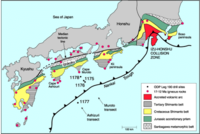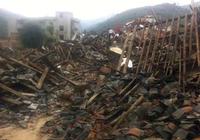-
Inexpensive, home-made quake early-warning system can be a life saver

UC Berkeley astrophysics professor Josh Bloom has developed an earthquake early-warning (EEW) device meant for the home or office. Resembling a home fire alarm or carbon monoxide sensor, the device was built using a Raspberry Pi single-board computer, an SD card, wired power speaker, and mini Wi-Fi adapter — costing roughly $110 in parts.
-
-
Japan boasts an earthquake early-warning system, but critics question its value

Since 1979, scientists with the Japanese earthquake prediction program have been monitoring a stretch of coastline southwest of Tokyo, watching for ground motion which might signal a pending rupture on the nearby fault zone. If motion is detected, Japanese law requires the prime minister to issue an emergency warning to close schools, secure hospitals, and shut down critical public transportation systems. Critics argue Japan will be unable to predict earthquakes in the same manner meteorologists track approaching typhoons or rain storms, saying that the program offers false hope.
-
-
ShakeAlert’s performance during August Napa tremor should lead to regional deployment: Supporters
Before the magnitude-6 earthquake struck Napa County late August, the Bay Area Rapid Transit received an alert ordering trains to stop, and some 911 operators had a few seconds of warning to brace for an influx of calls from concerned residents. The success of ShakeAlert, California’s earthquake early-warning system currently in the testing phase, has encouraged state lawmakers to push for funding — and deploying — the regional early warning system.
-
-
Experts defend operational earthquake forecasting

After the devastating 2009 L’Aquila earthquake in Italy, critics suggested that operational earthquake forecasting (OEF) is ineffective, distracting, and dangerous. In an editorial published in the Seismological Research Letters, experts defend OEF, arguing the importance of public communication as part of a suite of activities intended to improve public safety and mitigate damage from earthquakes.
-
-
Improving earthquake early warning systems, data collection
Researchers are working on what will be the U.S. first earthquake early warning system available to the public. Once fully implemented, the system will use networks of seismic instrumentation to detect when an earthquake is pending and send alerts via text message or other mass notification systems to people. The researchers are also workingon the Quake-Catcher Network to improve monitoring of earthquake activity around the world. Officials and city planners can use the data provided by Quake-Catcher to help decide where to build critical infrastructure such as power plants, hospitals, and water lines.
-
-
Napa earthquake may persuade lawmakers to fund earthquake warning system
Last Sunday’s Napa earthquake may push Congress to increase funding for an earthquake warning system. Building out the West Coast earthquake warning system, called ShakeAlert, would cost $120 million over five years, and an additional $16 million a year to operate. Today, ShakeAlert operates in a testing phase, and sensors notify researchers and volunteer participants when an earthquake has been detected.
-
-
Sunday tremor may accelerate deployment of West Coast early warning system
Researchers and individuals working with California’s ShakeAlertsystem received a 10-second warning before last Sunday’s earthquake struck the San FranciscoBay Area at 3.20 a.m. “Earthquake! Earthquake!” the warning system cautioned, followed by “Light shaking expected in three seconds.” Mexico and Japan already have a public earthquake warning system, but a collaboration in California among several institutions to create a similar system is still in an experimental phase. The project needs about $80 million for equipment, software, and other seismic infrastructure upgrades to launch the warning system throughout the West Coast.
-
-
First federal funds for West Coast earthquake warning system
Efforts by California officials to expand an earthquake warning system for the West Coast gained ground last Tuesday as the House Appropriations Committeerecommended $5 million — the first federal funds specifically for the project — toward the warning system. Analysts project the system will cost $38.3 million to build, and $16.1 million a year to operate and maintain. The $5 million would allow the purchase and installation of additional sensors and hiring of staff.
-
-
States choose different paths to deploying public alert systems
Thanks to systems such as the Federal Emergency Management Agency’s (FEMA) Integrated Public Alert & Warning System (IPAWS), the technology which allows governments to notify residents quickly of an emergency is becoming increasingly cheaper and more effective. Because of this, states are choosing different and unique paths toward deploying such systems within their infrastructure. States are choosing between giving local governments the lead on alert systems or providing extensive state-wide oversight.
-
-
Experts urge deployment of earthquake warning system in California
Scientists say that California has “99.7 percent chance of experiencing a severe earthquake — magnitude 6.7 or higher on the Richter scale — within the next 30 years.” These scientists are urging Congress to consider funding the full-scale deployment of an early-warning earthquake system on the western coast of the United States following successful testing of a prototype and positive results from similar international systems.
-
-
Inexpensive seismic alert device may help Mexico City residents

Mexico City has been experiencing an unusually large number of tremors within the past few months, and though the country has one of the most advanced seismic alert systems in the world, many residents are unable to receive notifications before tremors occur. Mexican regulations limit the sale of government-issued earthquake alert receivers to one private company, but since the receivers cost an average of $310, most families are unable to afford them. Andres Meira, a 39-year-old architect, has designed an earthquake alert receiver, which costs only $54 at retail, which taps into the government’s earthquake alert frequency to notify its users of a pending earthquake.
-
-
Small Virginia town debates cost of emergency siren system
Installing an emergency siren system in Danville, Virginia would be too expensive, Danville fire chief David Eagle said during a recent update to the Danville city council on emergency notification systems. The city’s last siren system was discontinued about twenty-five years ago. A new system would cost between $300,000 and $400,000 to install, and would incur annual maintenance cost.
-
-
New phone alerts for extreme weather events may prevent casualties in India
India has a mobile phone subscriber base exceeding 929 million people and this is expected to touch 1.15 billion by the end of 2014. An alert system developed for mobiles could reach an estimated 97 percent of the population. Computer science undergraduates have created image-based mobile phone alerts, connected to the Weather Research and Forecasting system.
-
-
Earthquake early warning? There’s an app for that
Researchers from the University of California have unveiled a smartphone app designed to provide users an early warning of approaching earthquakes. Based on the proximity of the user to the earthquake’s epicenter, the app will provide alerts of between a few seconds and one minute before a tremor hits.
-
-
Better earthquake early-warning system
Geophysicists have developed a new way of calculating the magnitude of an imminent earthquake by making better use of measurements of the compression waves produced early in the event. They say that the technique could be used to create a better early-warning system for earthquakes that could be used worldwide.
-
- All
- Regional
- Water
- Biometrics
- Borders/Immig
- Business
- Cybersecurity
- Detection
- Disasters
- Government
- Infrastructure
- International
- Public health
- Public Safety
- Communication interoperabillity
- Emergency services
- Emergency medical services
- Fire
- First response
- IEDs
- Law Enforcement
- Law Enforcement Technology
- Military technology
- Nonlethal weapons
- Nuclear weapons
- Personal protection equipment
- Police
- Notification /alert systems
- Situational awareness
- Weapons systems
- Sci-Tech
- Sector Reports
- Surveillance
- Transportation
Advertising & Marketing: advertise@newswirepubs.com
Editorial: editor@newswirepubs.com
General: info@newswirepubs.com
2010-2011 © News Wire Publications, LLC News Wire Publications, LLC
220 Old Country Road | Suite 200 | Mineola | New York | 11501
Permissions and Policies
Editorial: editor@newswirepubs.com
General: info@newswirepubs.com
2010-2011 © News Wire Publications, LLC News Wire Publications, LLC
220 Old Country Road | Suite 200 | Mineola | New York | 11501
Permissions and Policies
